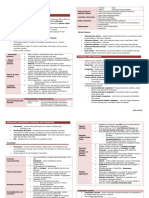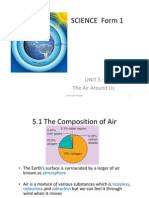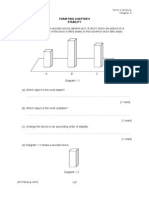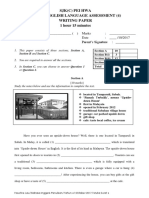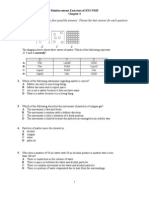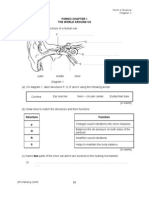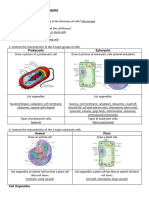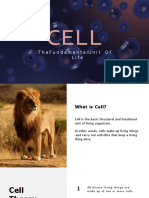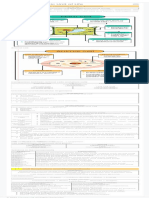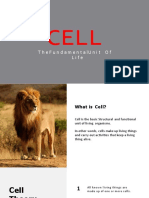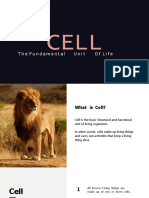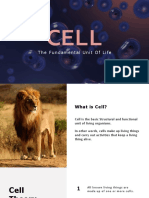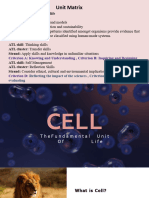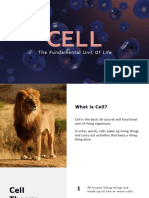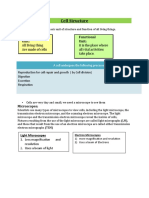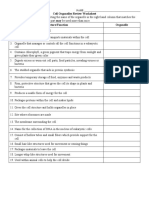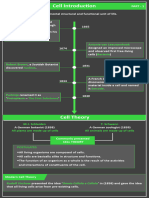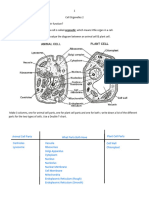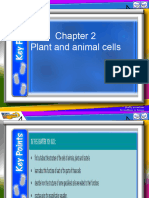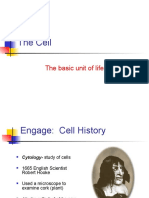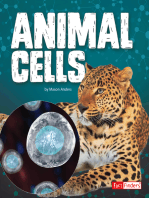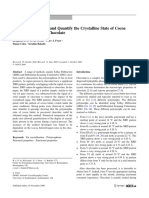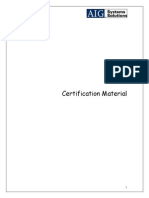05 - Master MyDLP Science (CH2) F1
05 - Master MyDLP Science (CH2) F1
Uploaded by
PANG KEE TIN MoeCopyright:
Available Formats
05 - Master MyDLP Science (CH2) F1
05 - Master MyDLP Science (CH2) F1
Uploaded by
PANG KEE TIN MoeOriginal Description:
Original Title
Copyright
Available Formats
Share this document
Did you find this document useful?
Is this content inappropriate?
Copyright:
Available Formats
05 - Master MyDLP Science (CH2) F1
05 - Master MyDLP Science (CH2) F1
Uploaded by
PANG KEE TIN MoeCopyright:
Available Formats
CHAPTER
Cell as the Basic
2 Unit of Life
NOTES
1 Cell is a basic unit of living things. 5 Types of cell in animals:
2 There are two types of cells, the animal cell and
the plant cell.
Cell membrane Cell wall
2
Cytoplasm Vacuole Muscle cells Epithelial cells
CHAPTER
Nucleus Chloroplast
3 Main differences between structure of animal cells Red blood cells Nerve cells
and plant cells:
Nukleus
Cell Nucleus
Nucleus
Animal cells Plant cells
component
Cell wall Absent Present
White blood cells Ovum Sperm
Reproductive cells
Chloroplast Absent Present
6 Types of cell in plants:
Vacuole Absent Present
4 Unicellular and multicellular organisms:
Unicellular Multicellular
organisms organisms
Guard cells Epidermal cell
Organisms that only Organisms that consist Guard cell
consist one cell more than one cell
Examples: Examples:
• Chlamydomonas • Spirogyra
• Amoeba • Mucor
• Paramecium • Hydra
• Euglena • Cat
• Human
Root hair cell Palisade cell
© Global Mediastreet Sdn. Bhd. (762284-U) 27
Master MyDLP Science(CH2)F1.indd 27 27/11/2020 12:56 PM
7 Sequence of cell organisation 11 Energy produced by cellular respiration is used
for various activities and life processes in the
Cell Tissue Organ cell.
12 During photosynthesis, the reaction in reverse
occurs.
In the presence of chlorophyll, the reaction below
Organism System occurs:
Light
8 There is various system in human body. energy
Example: Carbon
+ Water Glucose + Oxygen
dioxide
Nervous system Chlorophyll
Organs:
Brain 13 Carbon dioxide in the atmosphere is converted
into food (glucose) by green plants through
photosynthesis.
2
Spinal cord
14 Through the food chain, food (glucose) is
CHAPTER
distributed and used by all living things
during cellular respiration. This process
again releases carbon dioxide into the
atmosphere.
Nerves 15 Oxygen that is released by photosynthesis is used
in cellular respiration in all living things.
16 The presence of green plants is importance in
maintaining the level of carbon dioxide and oxygen
9 The two types of respiration are external respiration in the atmosphere.
(breathing) and internal respiration (cellular
respiration).
10 During cellular respiration,
Carbon dioxide
+
Glucose
Water
+
+
Oxygen
Energy
© Global Mediastreet Sdn. Bhd. (762284-U) 28
Master MyDLP Science(CH2)F1.indd 28 27/11/2020 12:56 PM
2.1 Cell – Structure, Function and Organization
1 What is meant by cell? PL 1
2 Why does cell can only be seen through a microscope?
3 Did cell carry out the life process?
Mark (3) for the correct answer.
Yes No
2
Give your reason.
CHAPTER
4 The following diagram shows two types of cell that can be observes under a microscope. PL 2
(a) Label the following cells. MODUL HEBAT 23
(i)
(iv)
(v)
(ii)
(vi)
P (vii) Q
(iii)
Achieved
PL 1 Recall the knowledge and science skills on cell as the basic unit of life
Not Yet Achieved 2
© Global Mediastreet Sdn. Bhd. (762284-U) 29
Master MyDLP Science(CH2)F1.indd 29 27/11/2020 12:56 PM
(b) Identify the above cells.
P:
Q :
(c) State the cell structure and their function.
(i)
Nucleus
(ii)
Place where the chemical reaction occurs
2
(iii) Cell
CHAPTER
membrane
(iv)
Cell wall
(v)
Stores water and gives support to cell
(vi)
Mitochondria
(vii)
Absorbs light energy to carry out photosynthesis process
SCIENCE INFO
Antonie van Leeuwenhoek
have created a high definition
microscope in 1674
Achieved
PL 2 Understand cell as the basic unit of life and able to explain their understanding
Not Yet Achieved 16
© Global Mediastreet Sdn. Bhd. (762284-U) 30
Master MyDLP Science(CH2)F1.indd 30 27/11/2020 12:56 PM
5 Complete the following double bubble map to show the similarities and difference between animal cells and
plant cells.
(b)
(c)
Small size
(a)
Have
Have
cytoplasm
cell wall
2
(d)
CHAPTER
Do not have Have cell
chloroplast membrane
6 State the definition of unicellular organism and multicellular organism.
(a) Unicellular organism
(b) Multicellular organism
© Global Mediastreet Sdn. Bhd. (762284-U) 31
Master MyDLP Science(CH2)F1.indd 31 27/11/2020 12:56 PM
Parame
7 Name the following organisms.
2-7 Then, classify them using the tree map below.
(a) (b) (c) (d)
Paramecium
Eugle
p2.15
p2.16
Euglena
Organisms
2
CHAPTER
Unicellular organisms Multicellular organisms
Amoeba Hydra
8 Name the human cells below and state their functions. PL 2
(a) Name:
Function:
(b) Name:
Function:
© Global Mediastreet Sdn. Bhd. (762284-U) 32
Master MyDLP Science(CH2)F1.indd 32 27/11/2020 12:56 PM
(c) Name:
Function:
(d) Name:
Function:
(e) Name:
Function:
2
(f)
CHAPTER
Name:
Function:
9 Match the type of plant cell correctly based on the statement below.
(a) Opening and closing of stoma is controlled by
this cell
Epidermal cell
(b) This cell absorbs water and nutrient from soil.
Palisade cell
(c) Enable gases exchanges and reduce loss of water
Root hair cell
(d) This cell consists of chlorophyll and absorbs light
to carry out photosynthesis process
Guard cell
Achieved
1PL 2
L Lengkapkan
Understand cell as the basic unit of life and able to explain their understanding
maksud istilah berikut dalam konteks organisasi sel. Not Yet Achieved 12
© Global Mediastreet Sdn. Bhd. (762284-U) 33
Master MyDLP Science(CH2)F1.indd 33 27/11/2020 12:56 PM
10 Complete the following terms in the context of cell organization.
(a)
p2.7 Cell
The basic unit that has the same and
(b) Tissue
p2.8
A group of same
Organ
(c) p2.9
A group of different that perform the same function
together
2
CHAPTER
System
A group of different that have different functions but carry
(d) p2.10
out the same operation
(e) Organism
All are functioning in an integrated to form the organism
11 Name the examples of systems in human body for the following diagram and complete the table.
(a) Brain (b) Skull (c)
Rib cage Heart
Spinal cord
Backbone
Blood vessels
Nerves Bone
© Global Mediastreet Sdn. Bhd. (762284-U) 34
Master MyDLP Science(CH2)F1.indd 34 27/11/2020 12:56 PM
(d) (e) (f)
Male
Skin
Nose
Lungs
Testis
Penis
Trachea
Female
Lungs Kidney Uterus
Ovary
Vagina
2
(g) (h) (i)
Mulut
CHAPTER
Mouth
Mouth Pituitary gland
Esofagus Otot-otott
Oesophagus
Oesophagus Muscles
Muscles Thyroid gland
Hati
Liver Perut
Liver Stomach
Stomach
Pankreas Pancreas
Pancreas
Pancreas Adrenal gland
Usus besar
Large intestine
Large intestine
Testis
Small
Ususintestine
kecil
2 - 20
(j) (k)
Skin
Nodus
Lymph nodes
limfa QUIZ
Lymph vessels
Salur
limfa
SCIENCE INFO
Skin is the largest organs in
human body.
© Global Mediastreet Sdn. Bhd. (762284-U) 35
Master MyDLP Science(CH2)F1.indd 35 27/11/2020 12:56 PM
System Function
(a)
(b) Supports the body, maintains its shape and protects the internal organs
(c) Carries oxygen and nutrients to all parts of body
(d)
(e)
(f) Produces ovary and sperm to form offspring
2
CHAPTER
(g) Breaks food into simpler molecules so that can be absorb by body
(h)
(i) Secretes hormones to coordinate body functions
(j)
(k) Controls body temperature
ACTIVITY • INFORMATION TECHNOLOGY & COMMUNICATION • PAK-21
Conduct the following activity. PAK-21 Suggestion
Procedures:
1. Read the following statement
Human is a complex multicellular organism
2. Gather information about the statement using various sources of information such as the internet, books and
others.
3. Discuss with other group members about the information.
4. Present the project by using a multimedia presentation in Microsoft Powerpoint.
© Global Mediastreet Sdn. Bhd. (762284-U) 36
Master MyDLP Science(CH2)F1.indd 36 27/11/2020 12:56 PM
2.2 Cell Respiration and Photosynthesis
1 State the meaning of the following types of respiration.
(a) External respiration
(b) Internal respiration
2CHAPTER
2 The following diagram shows a process that occurs in a human cell.
(i) (iii)
Energy produced
(ii) (iv)
(a) Label the cells in the diagram above using the words below.
Water Light Glucose Starch Carbon dioxide Oxygen
(b) Name the process that occurs.
(c) What is the use of energy produced?
© Global Mediastreet Sdn. Bhd. (762284-U) 37
Master MyDLP Science(CH2)F1.indd 37 27/11/2020 12:56 PM
3 Complete the following equation to explain the photosynthesis process.
(a) + Water (b) Glucose + (c)
Light
4 Complete the table below to show the difference between cellular respiration and photosynthesis.
Cellular respiration Photosynthesis
Happens in plant cells that contain
(a)
chlorophyll
(c)
Happens all the time
2
Carbon dioxide is absorbed and oxygen is
(b)
released
CHAPTER
Energy is produced (d)
Food is broken down (e)
5 Green plant makes their own food through photosynthesis process.
(a) Underline the correct answer.
(i) Plants need (chlorophyll, glucose) to carry out photosynthesis process.
(ii) Photosynthesis is a process that (releases, absorbs) energy.
(b) State two other needs for photosynthesis process.
1.
2.
(c) How we can identify that the plants carry out photosynthesis? Explain. KBAT
© Global Mediastreet Sdn. Bhd. (762284-U) 38
Master MyDLP Science(CH2)F1.indd 38 27/11/2020 12:56 PM
K B A T CORNER
1 The following table shows the results of an experiment study on the growth of Euglena (unicellular microorganism)
after three days. Three petri dish J, K and L were kept under different temperature at 10°C, 30°C and 70°C.
Amount of Euglena/per cm3 Dish J Dish K Dish L
Initial 20 20 20
Final 45 215 22
(a) Where is the natural habitat of Euglena?
(b) Suggest another microorganism that can be used to replace Euglena in the experiment. Explain the reason of
2
your suggestion.
CHAPTER
PISA /TIMSS CORNER
The following diagram shows a plant cell.
TIMSS Questions
What is the function of part label P?
© Global Mediastreet Sdn. Bhd. (762284-U) 39
Master MyDLP Science(CH2)F1.indd 39 27/11/2020 12:56 PM
MEMORY BOOST
Cell as a Basic Unit of Life
Cell – Structure, function and organization Cellular respiration and photosynthesis
Cell division Using the microscope
Experiments to
determine the
Normal cells Preparation of slides – requirements for
Complement photosynthesis
Cancer cells human cheek cells and
each other
2
onion cells
CHAPTER
Basic structures of 9
Basic structures found in plant
all cells cells only (occur in all living cells)
Nucleus Cell wall
Cytoplasm 2
1 3 Energy
10 +
+
Organism Oxygen
11
+
Unicellular Multicellular Water
Amoeba Hydra
Euglena Spirogyra Photosynthesis
Mucor (occur in green plants)
4
Bee
5 Human
Cell organisation
6
Cell
Types and functions of cells
12
13
Example of human cells: Example of plant cells:
14
7 Red blood cells transport 8 enable photosynthesis
to the whole body to be carried out efficiently Organism
© Global Mediastreet Sdn. Bhd. (762284-U) 40
Master MyDLP Science(CH2)F1.indd 40 27/11/2020 12:56 PM
SUMMATIVE PRACTICE
1 Diagram 1 shows a type of cell.
L:
K:
M:
2CHAPTER
Diagram 1
(a) Label the structures K, L and M using the words in the box below.
Chloroplast Cell wall Nucleus
[3 marks]
(b) Draw lines to match the structures and their functions.
Structures Functions
K Controls all cell activities
L Carries out photosynthesis
M Maintains the shape of cells
[3 marks]
2 (a) Complete the following sentences to explain the terms in cell organisation.
(i) Tissue is a group of that have the same characteristics and functions.
(ii) System is a group of that have different functions but carry out one operation.
[2 marks]
© Global Mediastreet Sdn. Bhd. (762284-U) 41
Master MyDLP Science(CH2)F1.indd 41 27/11/2020 12:56 PM
(b) Diagram 2 shows the blood circulatory system in human body. Red blood cells in the blood carry oxygen.
The heart pumps blood to the brain, lungs, digestive tract, liver and kidneys. Aorta is one of the blood vessels
that carries blood.
Otak
Brain
Brain
Peparu
Lungs
Lungs
Aorta
Jantung Aorta
Aorta
Heart
Heart
Hati Salur
Liver pencernaan
Liver Digestive tract
Digestive
Kidneys tract
Ginjal
Kidneys
2
CHAPTER
Diagram 2
(i) Complete the cell organisation below by using the examples in the blood circulatory system. Fill in the
blanks in the diagram below.
Human
Tissue
Cell organisation
[3 marks]
(ii) Which of the following is the function of the blood circulatory system?
Tick (✓) in the box provided.
Sending carbon dioxide to the kidneys
Sending oxygen to liver
Sending nerve impulses to the brain
[1 mark]
© Global Mediastreet Sdn. Bhd. (762284-U) 42
Master MyDLP Science(CH2)F1.indd 42 27/11/2020 12:56 PM
3 (a) Diagram 3.1 shows various types of cells which are found in the human body.
P Q R S T
Diagram 3.1
Based on Diagram 3.1, write P, Q, R, S and T to determine the cell which is found in the
(i) reproductive system :
(ii) blood circulation system :
[2 marks]
2CHAPTER
(b) Diagram 3.2 shows a system in the human body.
Diagram 3.2
Give two functions of the system.
(i)
(ii)
[2 marks]
(c) Zarul having a difficulty in defacate. As a doctor, what is your suggestion on his diet to overcome this problem?
–
–
–
–
[2 marks]
© Global Mediastreet Sdn. Bhd. (762284-U) 43
Master MyDLP Science(CH2)F1.indd 43 27/11/2020 12:56 PM
4 Diagram 4 shows the relationship between process P and process Q.
Cahaya Matahari
Sunlight
Sunlight
menghasilkan
produces
digunakan
is used produces
is used
Process
ProsesPP
Process P
Karbon
2
Carbon
dioksida Air
Water Glucose
Glukosa Oksigen
Oxygen
CHAPTER
dioxide
Carbon Water Glucose Oxygen
dioxide
Proses Q
ProcessQQ
Process
menghasilkan
produces is used
digunakan
produces is used
Tenaga
Energy
Energy
Diagram 4
Based on the Diagram 4, mark (✓) for the correct statement and mark (✗) for the incorrect statement.
(a) Process P and Process Q are reactions that complement each other.
(b) Light energy is absorbed in process Q to produce energy in cells.
(c) Oxygen that is released in process P is used in process Q.
(d) Both processes P and Q require carbon dioxide.
(e) Without process P, the contents of carbon dioxide in the atmosphere will keep increasing.
[5 marks]
© Global Mediastreet Sdn. Bhd. (762284-U) 44
Master MyDLP Science(CH2)F1.indd 44 27/11/2020 12:56 PM
You might also like
- Robbins Pathology - Chapter 4 TransDocument9 pagesRobbins Pathology - Chapter 4 Transnath nath100% (3)
- The French South American Quadruple-Screw "Lutetia.": IN LinerDocument9 pagesThe French South American Quadruple-Screw "Lutetia.": IN LinerTom BatesNo ratings yet
- Five Star-2019-Specification PDFDocument20 pagesFive Star-2019-Specification PDFmilkaNo ratings yet
- An Overview of P-Delta AnalysisDocument8 pagesAn Overview of P-Delta AnalysisMuhammad Saqib Abrar100% (1)
- Nota Ringkas Sains PMRDocument14 pagesNota Ringkas Sains PMRMohd Raimi Rahim0% (1)
- Sains Form 1 - Nota-PendekDocument9 pagesSains Form 1 - Nota-PendekAMILIA BT ARIFIN -No ratings yet
- PT3 Science PMR HighlightsdDocument14 pagesPT3 Science PMR HighlightsdAnonymous bwVxI8Y8W100% (3)
- Form 1 Science Chapter 5 Part 1Document21 pagesForm 1 Science Chapter 5 Part 1qq235100% (1)
- Math Exercise Chapter 2 Form 1 (Continue) by KelvinDocument8 pagesMath Exercise Chapter 2 Form 1 (Continue) by KelvinKelvinNo ratings yet
- Chapter 5 Thermochemistry 热化学: Endothermic reactions and exothermic reactionsDocument4 pagesChapter 5 Thermochemistry 热化学: Endothermic reactions and exothermic reactionsJue Hazea Goldshop100% (1)
- Physics Chapter 3 f4 KSSM (SPM Notes 4.0)Document18 pagesPhysics Chapter 3 f4 KSSM (SPM Notes 4.0)Dhievakar ParamesivanNo ratings yet
- Science Paper1 MidYear2014 Form 2Document8 pagesScience Paper1 MidYear2014 Form 2Nor AdilaNo ratings yet
- Lesson Plan 1 KHA (Fri, 9 Dec) NewDocument5 pagesLesson Plan 1 KHA (Fri, 9 Dec) NewnurNo ratings yet
- Trial Bio SPM SBP 2010Document78 pagesTrial Bio SPM SBP 2010Rozaini Othman75% (8)
- Science Form 2 Objective QuestionsDocument11 pagesScience Form 2 Objective QuestionsImann Ieja AisyahNo ratings yet
- Teaching Learning Module KSSR Science Year 6Document128 pagesTeaching Learning Module KSSR Science Year 6fasyarinaNo ratings yet
- Module Science Pt3Document11 pagesModule Science Pt3lccjane8504No ratings yet
- Module Chapter 1Document41 pagesModule Chapter 1sakinahNo ratings yet
- F2 Is 003 AcidDocument4 pagesF2 Is 003 AcidLorraine TsoiNo ratings yet
- Dear MR Kilmer Form 5 SPMDocument4 pagesDear MR Kilmer Form 5 SPMenesusNo ratings yet
- MODUL Dear MR Kilmer Form 5 SPMDocument24 pagesMODUL Dear MR Kilmer Form 5 SPMSyamila Syafawani57% (7)
- Form 2 Chapter 9Document10 pagesForm 2 Chapter 9naza9775100% (3)
- CHAPTER 3 Coordination ResponseDocument19 pagesCHAPTER 3 Coordination ResponseRozalina AzianNo ratings yet
- F3 Chapter 4 Reactivity of MetalsDocument11 pagesF3 Chapter 4 Reactivity of MetalsJue Hazea GoldshopNo ratings yet
- Bi Penulisan (Diagnostic Test)Document6 pagesBi Penulisan (Diagnostic Test)JennyLu15No ratings yet
- Additional Science 2010 SPMDocument15 pagesAdditional Science 2010 SPMArthur JonnesNo ratings yet
- Food Web and Food Chain WorksheetDocument3 pagesFood Web and Food Chain WorksheetCharles TapanganNo ratings yet
- Contoh Simple English EssayDocument8 pagesContoh Simple English EssaynoorhashilaNo ratings yet
- Chapter 2: Cell Structure and Cell Organisation: Figure 1 (I) Figure 1 (Ii)Document37 pagesChapter 2: Cell Structure and Cell Organisation: Figure 1 (I) Figure 1 (Ii)Jonathan LingNo ratings yet
- Chapter 2 Cell As A Unit of LifeDocument8 pagesChapter 2 Cell As A Unit of Lifenaza9775100% (5)
- RTS PMR Question Bank Chapter 3 2008Document7 pagesRTS PMR Question Bank Chapter 3 2008iwan93No ratings yet
- Form 2 Chapter 1Document6 pagesForm 2 Chapter 1naza977562% (13)
- Meiosis BIOLOGY Form 4 Chapter 5 Cell DivisionDocument23 pagesMeiosis BIOLOGY Form 4 Chapter 5 Cell DivisionYihui WongNo ratings yet
- 5.1 ElectronDocument53 pages5.1 ElectronFarish MikhaelNo ratings yet
- 2016 Unit 3 4 Chemistry No ActivitiesDocument23 pages2016 Unit 3 4 Chemistry No ActivitiesAnonymous mlz92VdKyqNo ratings yet
- Form 2 Science Exercise by Kelvin - Chapter 5Document4 pagesForm 2 Science Exercise by Kelvin - Chapter 5KelvinNo ratings yet
- Ting. 2 KSSM Bab 4Document18 pagesTing. 2 KSSM Bab 4arasiNo ratings yet
- Coordination & Response QuestionDocument18 pagesCoordination & Response QuestionTeddy BooNo ratings yet
- Answer Scheme Percubaan UpsrDocument5 pagesAnswer Scheme Percubaan UpsrVijaya Malar GunushakranNo ratings yet
- Science Form 3 - Chapter 3 - TransportationDocument6 pagesScience Form 3 - Chapter 3 - TransportationShatviga Visvalingam0% (1)
- Chapter 1 Safety Measures in LabDocument33 pagesChapter 1 Safety Measures in LabHema Lata100% (12)
- Cells Review Ws AnswersDocument4 pagesCells Review Ws AnswersTongtun TuntunNo ratings yet
- Thefundamentalunitof LifeDocument38 pagesThefundamentalunitof LifeDyah Anggraeni100% (1)
- Cell - Structure, Function and OrganizationDocument1 pageCell - Structure, Function and Organization- adlina -100% (1)
- Cell StructureDocument37 pagesCell StructureMARY ANN PANGANNo ratings yet
- Lecture 1 The Cell (Basic Unit of Life)Document35 pagesLecture 1 The Cell (Basic Unit of Life)AG STXLEZNo ratings yet
- The Fundamental Unit of LifeDocument38 pagesThe Fundamental Unit of LifevpsandhyaraamNo ratings yet
- Cell Structure and FunctionsDocument39 pagesCell Structure and Functionsshilpa SNo ratings yet
- The Fundamental Unit of LifeDocument38 pagesThe Fundamental Unit of LifeJohn alecxhander AdvinculaNo ratings yet
- The CellDocument38 pagesThe CellAlden VillavicencioNo ratings yet
- Animal Cells Grade 7Document8 pagesAnimal Cells Grade 7Mira Krasimirova IvanovaNo ratings yet
- Biol 1109 s24 04 CellDocument24 pagesBiol 1109 s24 04 Cellgeotina.kelseyNo ratings yet
- Cell Structure: Structural Functional Unit: UnitDocument13 pagesCell Structure: Structural Functional Unit: UnitHaya Attieh100% (1)
- 4 Structures and OrganellesDocument5 pages4 Structures and Organellessalmasadiq2008No ratings yet
- Cell - Structure, Function and OrganizationDocument4 pagesCell - Structure, Function and Organizationlavendarblue07No ratings yet
- Rajeem Outlaw Wright - Cell Organelle Review WorksheetDocument3 pagesRajeem Outlaw Wright - Cell Organelle Review WorksheetRajeem Outlaw WrightNo ratings yet
- Cell-Introduction MapDocument2 pagesCell-Introduction Mapankitraj969380No ratings yet
- Bab 2 Tingkatan 1Document58 pagesBab 2 Tingkatan 1azizahembong84No ratings yet
- Kami Export - Rishabh Roy - Cell Organelles 2Document8 pagesKami Export - Rishabh Roy - Cell Organelles 2bloomington369No ratings yet
- Unique Structure Organelles: Bacteria Cell 3 Common Things FlagellaDocument1 pageUnique Structure Organelles: Bacteria Cell 3 Common Things FlagellaBiNo ratings yet
- 2.1 Plant and Animal Cells-1Document40 pages2.1 Plant and Animal Cells-1chieffo.massimoNo ratings yet
- Activity 3Document3 pagesActivity 3enaniacanoNo ratings yet
- 2 Biology 1 - 2 - 07 Pro Vs Eu CellsDocument37 pages2 Biology 1 - 2 - 07 Pro Vs Eu CellsJuan Jaylou AnteNo ratings yet
- Lesson Proper For Week 1: Art HistoryDocument19 pagesLesson Proper For Week 1: Art HistoryFrahncine CatanghalNo ratings yet
- Types of Beams in ConstructionDocument7 pagesTypes of Beams in ConstructionJerico FloresNo ratings yet
- Short Story ElementsDocument27 pagesShort Story ElementsGlormarie Nieves100% (2)
- Says:Does:Because LaboutDocument3 pagesSays:Does:Because LaboutNeil McLeanNo ratings yet
- Leadership Styles in Project ManagementDocument2 pagesLeadership Styles in Project ManagementA ANo ratings yet
- Milk Chocolate - PXRD2Document8 pagesMilk Chocolate - PXRD2mayankbishtNo ratings yet
- The Translation of Culture Specific IssuDocument186 pagesThe Translation of Culture Specific IssuIbrahim HedwarNo ratings yet
- Certification Material PDFDocument224 pagesCertification Material PDFGaddam NeerajNo ratings yet
- Extruder SDocument4 pagesExtruder SAlfian HanafiNo ratings yet
- Service Manual: RefrigeratorDocument98 pagesService Manual: RefrigeratoryatinthoratscrbNo ratings yet
- Goblin Slayer - 15 (Yen Press)Document225 pagesGoblin Slayer - 15 (Yen Press)qwer50% (2)
- Theories of Educational Management PDFDocument25 pagesTheories of Educational Management PDFJose Belisar83% (6)
- Fate Lost Continuum - EXTRADocument32 pagesFate Lost Continuum - EXTRAEnzo BosquettiNo ratings yet
- Article About The Street FoodDocument5 pagesArticle About The Street FoodAnonymous qLU9xuhABWNo ratings yet
- Roman Amphorae Beyond The Frontiers of T PDFDocument46 pagesRoman Amphorae Beyond The Frontiers of T PDFbeogradjanin.smeker100% (2)
- Project On 14 Principle of Henri Fayol Management With References To V-MartDocument25 pagesProject On 14 Principle of Henri Fayol Management With References To V-MartLEARN WITH AGALYANo ratings yet
- MPA TRACKING FORM (NonThesis)Document1 pageMPA TRACKING FORM (NonThesis)Gloria Lambo GillacoNo ratings yet
- Student Reader - Unit 3Document32 pagesStudent Reader - Unit 3ozkankocakNo ratings yet
- Revised Practical Date Sheet For The Examination of AD Bachelors 2 Yea84453Document1 pageRevised Practical Date Sheet For The Examination of AD Bachelors 2 Yea84453Sidra ShahNo ratings yet
- Reading 702 SE 2Document5 pagesReading 702 SE 2rebeca 97No ratings yet
- UsermanualDocument36 pagesUsermanualAmanNo ratings yet
- Keeping A Cool Head in A Hot Market Edward Dobson PDFDocument36 pagesKeeping A Cool Head in A Hot Market Edward Dobson PDFtak01100% (4)
- Personality and Consumer BehaviourDocument40 pagesPersonality and Consumer BehaviourPramanaNo ratings yet
- Metal Can Defects CFIADocument210 pagesMetal Can Defects CFIARichard Miranda RomeroNo ratings yet
- CFA Level II - Equity - Equity Valuation Applications and ProcessesDocument10 pagesCFA Level II - Equity - Equity Valuation Applications and ProcessesQuy Cuong BuiNo ratings yet
